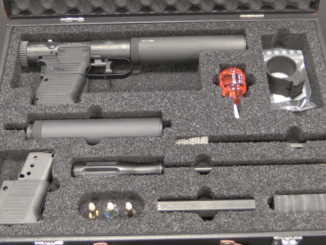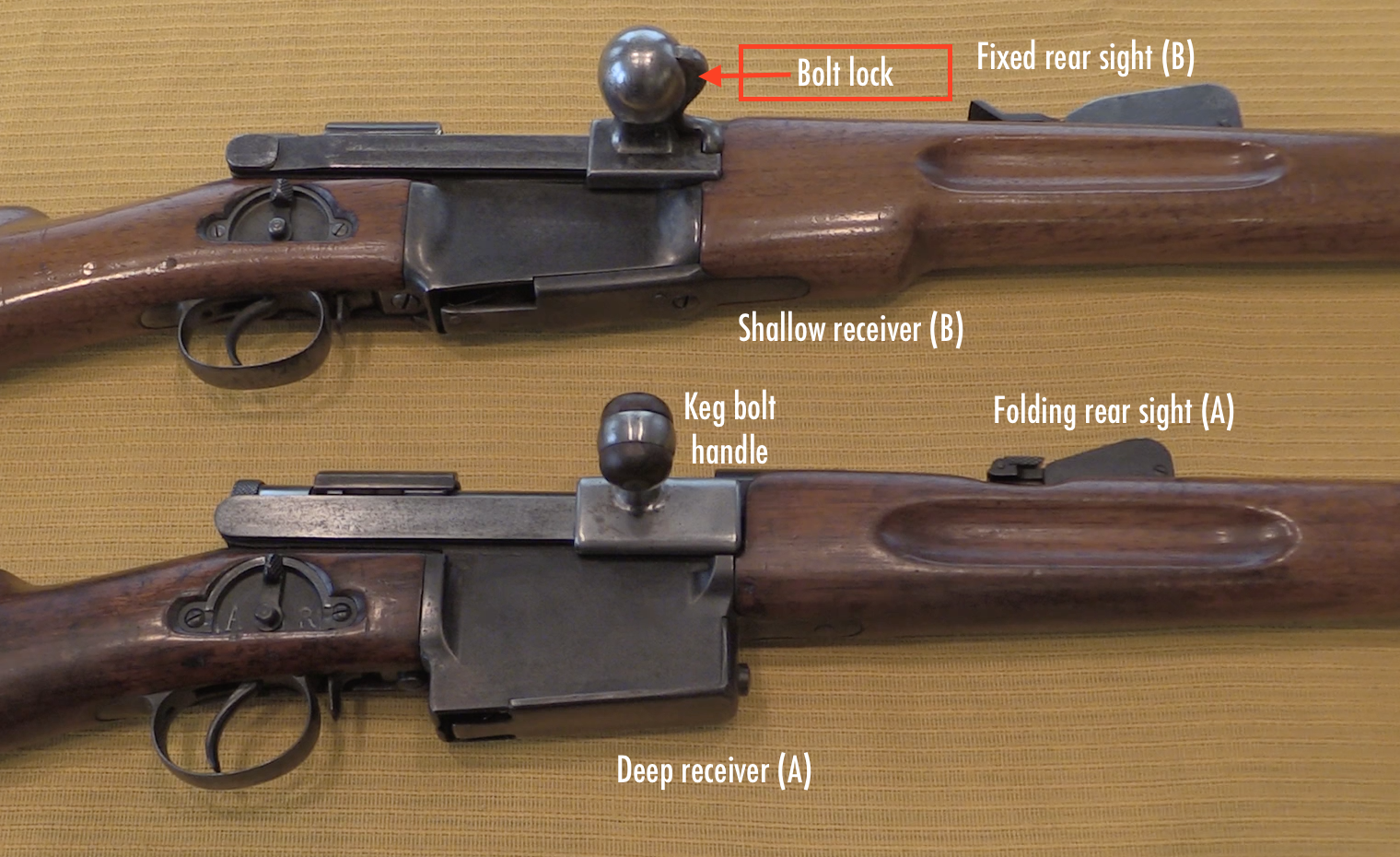The KE-7 was the product of two Swiss designers, Pal Kiraly and Gotthard End, and was introduced in 1929 by the Swiss manufacturer SIG. It was a recoil operated design and fired from an open bolt. The guns were not adopted by the Swiss military, and were exported primarily to Latin America, Ethiopia, and China, being mostly made in 8mm Mauser. They were tested by many European nations, and were offered in a wide variety of calibers. The rate of automatic fire would vary depending on caliber, but was not less than 550 rpm. Magazines were typically 25 rounds – although this example has a 50-round magazine.
The gun could fire in either single shot or automatic mode. It didn’t use a selector switch, though – pulling the trigger back slightly gave single shots, and a further pull gave automatic fire. This was a relatively common feature of submachine guns at the time, although not seen so much in light machine guns.
Thanks to the Institute of Military Technology for allowing me to have access to this magnificent piece and bring it to you!




Chinese Nationalist forces got a few KE7’s, along with Hotchkiss LMG’s, Zb-26’s, and the occasional MG34. Did I mess up?
“Chinese Nationalist forces”
Assuming that it is equal to Kuomintang:
photo: http://borianm.livejournal.com/430137.html
described as: adjective(Kuomintang) machine gunner. Early 1930s.
Please find below pictures of a Chinese / Kuomintang KE-7 LMG.
Note the unusual barrel shroud which is possibly a replacement part.
https://img4.hostingpics.net/pics/563595141.jpg
https://img4.hostingpics.net/pics/717673232.jpg
https://img4.hostingpics.net/pics/432809123.jpg
For me your links do not work properly. Anyone else have same issue?
As Ian stated, looks mighty expensive! Seems the Chinese characters were on offer from SIG for guns sold to the Chi-nats/Guomindang armies. I rather like the spring of the action also serving as the sear spring. On the other hand, well, mighty complicated to build, I’d say!
Very, very informative episode about what must be, truly, a long Forgotten Weapon! Thanks!
Looks like MG34 barrel shroud. Didn’t Chinese acquire small quantity of 34s?
A small correction: Pál Király was a Hungarian designer, not Swiss. He did work in Switzerland in the 1920s, where he worked for SIG Neuhausen.
That information was included in the presentation, along with information that the designer had been “featured” in other designs covered in Forgotten Weapons and should be in some upcoming videos.
Query Pál Király in English Wikipedia has following statement
In 1932 Király designed a self-loading (automatic rifle), which was the first automatic rifle in the world utilizing a muzzle brake (The more famous Simonov Model 1936 featured the first muzzle brake outside Hungary, 4 years later).
Which is false, as earlier existed in Автоматическая винтовка системы Дегтярева образца 1930 г. see drawing here:
http://commi.narod.ru/txt/markev/527.htm
Very interesting.
But I think it might actually be possible to quick change a hot barrel with that LMG.
Imagine that LMG down on its bipod in firing position with a right handed shooter in prone (or sitting?). A lifting twist with the right hand on the pistol grip disengages the receiver from the barrel housing unit, and also rotates the magazine horizontal so it clears ground obstructions. With the left hand holding the forend up, the receiver group is pulled clear, and then the left hand tilts down the rear end of the barrel group, pivoting on the bipod, and the weight of the barrel slides it clear out from the barrel housing. I imagine doing such a thing would also require aiming the rear end of the barrel housing away from the shooter so he doesn’t drop a hot barrel right under his face!
Such a procedure explains why there is such an elaborate forend under the barrel housing, and why the bipod is so tall. You really don’t need such a tall bipod for shooting a 25 round bottom feed magazine. In fact that bipod looks so tall would you have to use it in the sitting position?
“In fact that bipod looks so tall would you have to use it in the sitting position?”
Earlier post about this weapon: https://www.forgottenweapons.com/light-machine-guns/sig-ke-7/
Document El Fusil Ametralladora KE7 Report (Spanish) shows ways of possible usages (page 13 of PDF), it seems that mount for this weapon also was interesting device
Document SIG KE-7 Sales Brochure (English) shows Light machine gun Neuhausen KE 7 on bipod and butt rest (page 3 of PDF), this document also says that KE 7 has barrel removable without unloading, does it mean that barrel might changed with magazine fitted?
Interesting!
Cyclic 550 rpm, and weighs less than 20 pounds with a loaded 25 round magazine. Very nice indeed.
“Cyclic 550 rpm, and weighs less than 20 pounds with a loaded 25 round magazine. Very nice indeed.”
From this description looks similar to French MAC Mod. 1924/29:
http://modernfirearms.net/machine/fr/mac-m1924-e.html
which weight was 8,9 kg, magazine capacity also 25 but bit smaller RateOfFire of 450-500 rpm. This machine gun also has FULL and SINGLE modes, also without lever-selector, but with 2 triggers rather than two-stage trigger.
When laying prone behind a KE-7, the bipod never stood out to be that tall in my experience. It may only be an illusion.
Yeah, If I’m reading the numbers right from the German language manual the height of the sightline measured to the bottom of the bipod foot is only 14 inches which isn’t as high as my first impression.
Very good point. For that matter, if one rotated it, pulled off the rear end, and the assistant just sort of chucked the hot barrel off to the side and then put in a new one, it might be accomplished reasonably quickly too… I think your explanation of a single user is good, I’m just wondering about the assistant’s role in the process?
I’m wondering if at least somebody using this didn’t issue a heavy leather glove for removing the barrel, rather like the asbestos mitt for the U. S. M60 7.62 x 51mm GPMG.
cheers
eon
Tilting bolts that move vertically at the front and slide across the case head are uncommon. The Czech vz 52 used it.
What of the Simonov-designed AVS-36?
“They were tested by many European nations, and were offered in a wide variety of calibers.”
Among others Great Britain according to: http://guns.wikia.com/wiki/SIG_Neuhausen_KE7
According to http://forum.guns.ru/forum/36/850486.html
K. E. 7 (Neuhausen) was also tested in 1935 Brazilian LMG trials, which finally was won by Madsen
And if I mentioned Madsen, here is very simple solution to turn air-cooled to liquid-cooled 🙂
http://borianm.livejournal.com/425852.html
Hehehe very cool !!
Great video as always.
Note that a 3 position selector switch (safe-semi-full) was available as an optional feature and can be seen on factory demo guns.
In a typical Swiss fashion, even the bipod was over-engineered:
While a very simple detent mechanism could have worked to secure the whole bipod in place, it was deemed insufficient.
Therefore each leg was made of 2 steel tubes in a rather complex telescopic arrangement providing a positive lock-up in either the open or folded position.
As a side note:
The guns could be found in a variety of full power calibers of the era, including 7.5×55 / GP11.
Also prototype KE LMGs were made with top magazine feeding similar to the BREN LMG.
How did they ever make money on so elaborate designs ?
Not sure…but also remember that the small arms manufacture was one of several divisions within SIG.
The firm’s core business at the time was actually the manufacture of train carriages and later included packaging products for the food and beverage industry.
“money on so elaborate designs”
Notice that Madsen LMG was also bought by some South American states, despite it is not simple design by modern standards.
One detail (unless I missed it) not mentioned and pretty obvious is that barrel must have been kept in the back to wait for bolt carrier-bolt assembly to reengage and then let go forward. To arrange this is a reliable way is challenge by itself, let alone the rest. Overall, this thing is “nuts”.
Wouldn’t the designer’s name be pronounced KURR-eye? I recall it because there was a US Olympic volleyball player, I think, named Karch Kiraly, who had Hungarian heritage. I remember the sportscasters trying to get his name right.
The phrase ‘runs like a Swiss watch’ should be replaced with ‘runs like a Swiss machine gun.’ Amazing machining, for sure.
Correction: that’d be Kuh-rai.
Entry in Russian wikipedia: https://ru.wikipedia.org/wiki/Пистолет-пулемёт_Кирали
use form Кирали, which would give Kirali
At first it looked complicated but after it was explained how the action works it seems fairly simple and reliable.
Sure there are other parts that could be simpler but it’s the action that interests me most, I wonder how it would handle dirt or crappy ammunition?
I would love to see a machinists opinion on the difficulty of manufacturing, odd angles shouldn’t be a problem if there’s room to cut them imo.
Another example for that the swiss like complicated mechanics … only that it makes perfect sense in a watch, but none at all in a weapon.